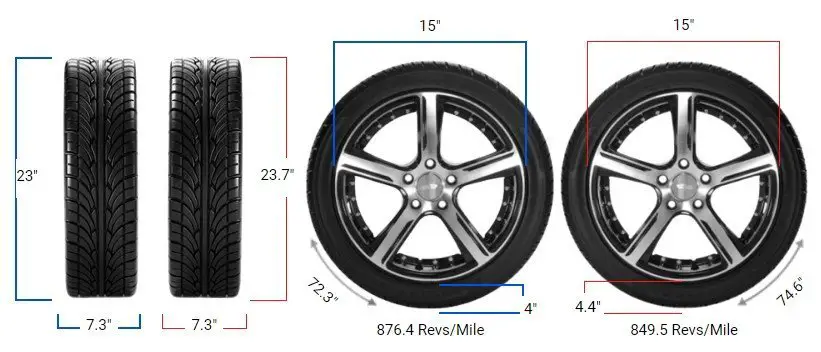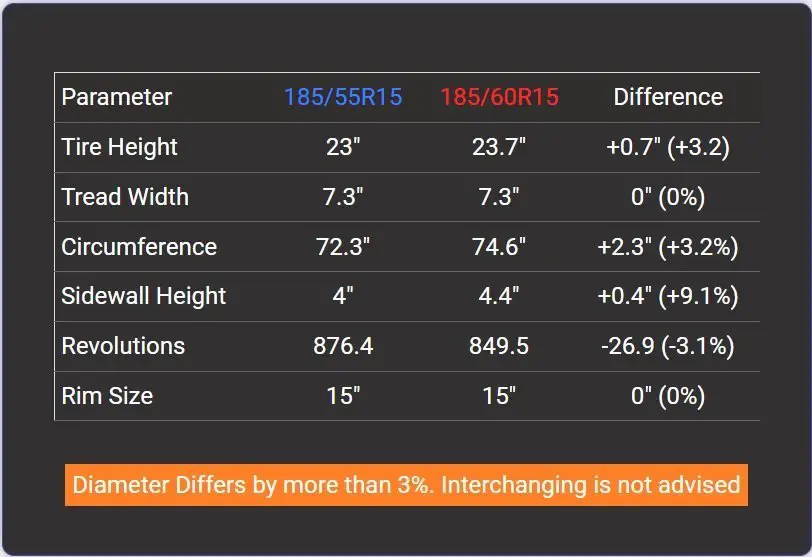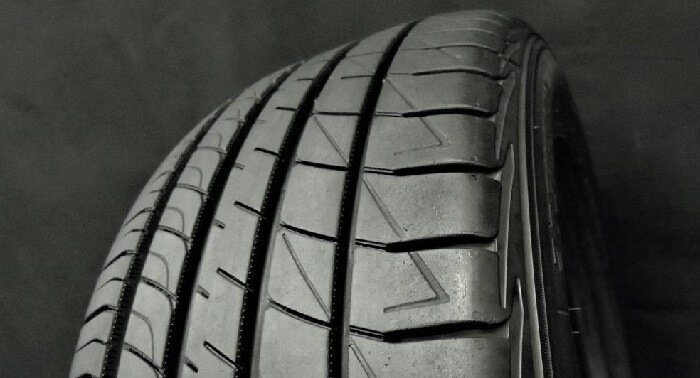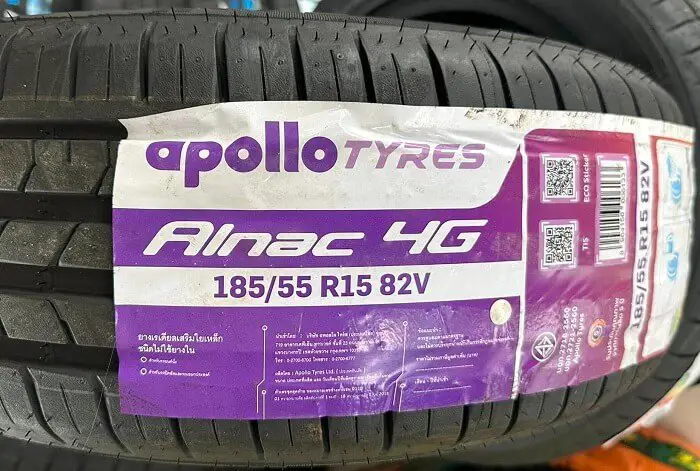Tire Size 185/55r15 vs 185/60r15

Changing tire sizes can have various effects on your vehicle’s performance and handling. If you’re considering switching from 185/55R15 to 185/60R15 tires, it’s essential to understand the implications of this change. We’ll explore the differences between these two tire sizes and their potential impact on your driving experience.
- The overall diameter difference between 185/55R15 and 185/60R15 tires is 3.2%
- The sidewall height of 185/60R15 tires is 9.1% taller than 185/55R15 tires
- Speedometer readings will be affected, with the actual speed being slightly higher than indicated
- Ground clearance and ride comfort may improve, but gas mileage and handling could be negatively impacted
185/55r15 vs 185/60r15 Table
The primary difference between 185/55R15 and 185/60R15 tires lies in their sidewall height. The 185/60R15 tires have a sidewall that is 9.1% taller than the 185/55R15 tires, resulting in a 3.2% increase in overall diameter.

Fitment Guide
In general, it’s best to stay within 3% of the original tire’s overall diameter when selecting replacement tires. The 3.2% difference in overall diameter between 185/55r15 and 185/60r15 sizes slightly exceeds this range.
It’s still possible to make this switch, but be aware of the potential impacts, especially if your vehicle has limited fender clearance.
On-Road Impact
Switching to a slightly taller tire will affect on-road performance and driving dynamics in a few key ways:
- Speedometer Accuracy: Because 185/60r15 tires have 3.1% fewer revolutions per mile, your speedometer will read about 0.6 mph slow for every 20 mph when making this switch. While this error is fairly minor, it’s something to be aware of, especially when using cruise control or GPS speed readings.
- Ride Comfort: The taller sidewall of 185/60r15 tires provides a bit more cushion between the road and the wheel compared to 185/55r15 tires. This can lead to a slightly smoother and more compliant ride, especially over rough pavement or potholes. However, some drivers may find the taller sidewall allows for more “float” or “squish.”
- Handling: While 185/60r15 tires maintain the same tread width as 185/55r15 tires, the taller sidewalls can slightly diminish steering response and cornering stability. The difference is likely to be subtle for most drivers, but those looking for maximum handling performance may prefer the shorter 185/55r15 sidewall.
- Durability & Tread Life: In general, tires with taller sidewalls tend to be somewhat more durable and have potential for longer tread life compared to lower profile tires of the same width and pattern. The taller sidewall better absorbs impacts that could otherwise cause wheel damage or punctures.

Off-Road Impact
If you drive your vehicle off-road, there are a few other factors to consider when switching from 185/55r15 to 185/60r15 tires:
- Ground Clearance: The 3.2% larger overall diameter of 185/60r15 tires will increase ground clearance by about 9mm or 0.36 inches. While modest, this additional clearance can be helpful for avoiding rocks, roots, and other obstacles, especially if your vehicle has limited stock clearance.
- Sidewall Protection: When aired down for off-road use, the taller sidewalls of 185/60r15 tires provide a bit more protection for the wheel lips. This can help avoid scrapes and dents from rocks and other debris.
- Gear Ratio Effects: The 3.1% difference in revolutions per mile between 185/55r15 and 185/60r15 tires will have a slight gearing effect, equal to numerically lower gearing. This change is quite small and likely hard to notice. Still, those running very large tires may need to account for gearing differences.

What is the Difference Between 185/55r15 and 185/60r15?
The main difference between 185/55r15 and 185/60r15 tires lies in the aspect ratio, which affects the sidewall height. The 185/60r15 tire has a taller sidewall compared to the 185/55r15 tire.
This difference in sidewall height leads to a larger overall diameter for the 185/60r15 tire, which is 0.73 inches (18.5 mm) taller than the 185/55r15 tire. The taller sidewall also results in a 3.2% difference in circumference and a 3.1% reduction in revolutions per mile.
Can I Use 185/60r15 Instead of 185/55r15?
While it is possible to use 185/60r15 tires instead of 185/55r15 tires, it is not generally recommended. The overall diameter difference between these two tire sizes is 3.2%, which slightly exceeds the typically recommended range of 3%.
Exceeding this range may lead to issues such as inaccurate speedometer readings, altered handling characteristics, and potential clearance problems. If you still choose to make the switch, be aware of these potential issues and make necessary adjustments to ensure safe operation.
How Much Taller Is a 185/60r15 Tire Than a 185/55r15?
A 185/60r15 tire is 0.73 inches (18.5 mm) taller than a 185/55r15 tire. This difference in height is due to the taller sidewall of the 185/60r15 tire, which is 0.36 inches (9.25 mm) taller than the sidewall of the 185/55r15 tire. The increased sidewall height results in a larger overall diameter for the 185/60r15 tire.
How Much Wider is a 185/60r15 Tire Than a 185/55r15?
The width of both 185/60r15 and 185/55r15 tires is the same at 7.28 inches (185 mm). The difference in the aspect ratio (60 vs. 55) affects the sidewall height but not the tire width. Therefore, a 185/60r15 tire is not wider than a 185/55r15 tire.
Our Observations
After analyzing the specs, the differences between 185/55r15 and 185/60r15 tires are noticeable but relatively minor overall. The 3.2% larger diameter of 185/60r15 tires will have small effects on speedometer accuracy, ride comfort, handling, and ground clearance. These differences may be more apparent to discerning drivers.
For most on-road driving, the differences between these two sizes are fairly negligible. However, if you have a performance-oriented vehicle and prefer sharper handling, sticking with 185/55r15 tires may be ideal. For general commuting and long-distance highway driving, 185/60r15 tires could provide a bit more comfort and durability.
Off-road, the taller sidewall of 185/60r15 tires offers a bit more cushion and protection for the wheels. The roughly 1/3″ increase in overall diameter can also help marginally in clearing obstacles. Still, the gearing difference is quite small. Ultimately, your specific vehicle and off-road usage will determine if 185/60r15 tires are preferable to 185/55r15.

Meet Caitlin McCormack, a Tire Size Expert and Blogger Passionate About Everything Related to Tires. With Years of Experience in the Tire Industry, Caitlin Has Become an Expert in Tire Sizes and Their Impact on Vehicle Performance.
